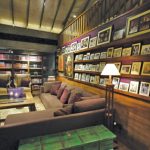
The need to carefully tread the earth during all human interventions is now well known. Being design friendly to the mother earth is now at the forefront of the thinking of creative designers leading to inventive products. Such designs often use by-products of the industry, reducing the amount of waste, or harness new sustainable materials or production techniques. Indeed, we will soon hear of fabric made from recycled plastic bottles or bamboo.
By Hiranthi Pathirana
Many designers are experimenting with innovative ways that would cause minimal negative impact on the environment. While recycled materials minimise the use of resources, biodegradable textile materials reduce the impact on the environment. Using plant-dyes instead of poisonous chemicals improve the appearance of fabrics.
This project was an effort to make the narrow non re-usable strip cuts to a better standard by adding value and making them fashionable
In this context, the undergraduates at the Department of Integrated Design, University of Moratuwa, ventured into in-depth research on the innovative use of waste materials. A recent project called on the students to produce designs that will re-use waste material. These involve discarded fabrics, plastic mineral water bottles, newspapers and corrugated cardboard boxes. What was presented were splendid and had derived inspiration from the unseen beauty of everyday objects.
Design project of fashion design
Most apparel is done with cut and sewn methods in mass scale garment factories. Some fabric is wasted while cutting the pattern pieces. Although some are re-used for different purposes, some are thrown away, polluting the environment. This project was an effort to make the narrow non re-usable strip cuts to a better standard by adding value and making them fashionable. In order to give them the fullest value, new materials were developed and were used in a contemporary bridal wear collection.
Fabric is a finished product. As such, considerable amounts of chemicals and water are used in the treatment of raw fibres, and energy consumed in spinning, weaving and knitting. They are also treated with various finishing chemicals, as well as dyed, using harmful substances to achieve particular colours. Fabric off-cuts come in different shapes and colours. When reusing them, the shape of the pieces and the ways of attaching them together should be considered. In this project, instead of sewing the narrow strips together, they were connected using knots and weaves developing a new fabric.
Fabric off-cuts were collected from Pamunuwa and tailor shops. They consisted of single jersey materials and satin. Single jersey materials are stretchable and knots can be tied with neatness of the edges. While the fine details were done with the off-cuts, soft materials were used as the supporting fabric. Additionally, detailing was done with beads as embellishments and as a connecting mode of the fabric stripes.
Furniture design project
Re-using saves the resources and energy needed to produce new materials, and involves none of the energy consumption or waste associated with recycling and reprocessing. Materials that have been reclaimed such as wood/timber can be given a second life by re-using them in innovative furniture. This means that less energy is consumed in making new products. It is amazing how strong, durable, and beautiful cardboard can be, when used in the correct manner to exploit its qualities. Cardboard is also recyclable, environmentally-friendly, and lightweight. They are easy to use, move and transport.
During the design process,the designers attempted to bring in the nature and characteristics of the cardboard as part of the character of the furniture itself. Exposed corrugation patterns and the original colour of cardboard were retained, while only the forms were manipulated to create the furniture.
Hundreds of sheets of newspaper were meticulously brought together, to create unique stools incorporating traditional handicraft techniques with cutting-edge contemporary design. Durable and ideal for interior use, the real beauty is in the fact that the newspaper stools are of entirely recycled material.
This project shows how designers can help tread the earth gently by being innovative. The world is full of waste, and they can indeed be resources for the future.
Acknowledgement: Shenuka Dias, Department of Integrated design, University of Moratuwa, Fashion Designer Shehara Allegedara and Furniture Designer Chaturika Nugawela.





















